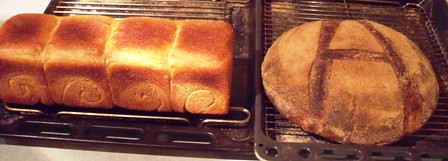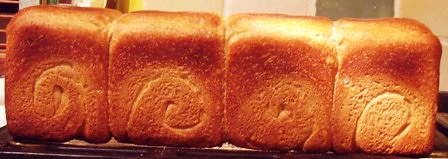
Most bookmarked

- Log in or register to post comments
- Printer-friendly version

First Time Pain à l'Ancienne Ciabatta (ABE Recipe) Challenges
Last night, I baked a loaf of Ciabatta for the first time. I am using Peter Reinhardt's "Artisan Bread Every Day", and I am fairly new to baking (two three months now, and probably 15 loaves). For those not familiar with the book, it uses a method of mixing the entire dough and retarding, rather than a two stage process.
I made the dough two days ago, and proofed it yesterday on a sheet plan lined with Parchment, and baked it in the convection setting at 425 degrees. The bread came out very tasty, but still needs a lot of improvement.
- The dough was very wet. PR says that this is the highest hydration dough in the book, but I don't know enough by feel yet to know if it was a bit too wet. It was quite difficult to handle. When proofing, it looked like a "blob" rather than a loaf.
- The seam under the loaf was still visible after baking. I guess the seam didn't really pinch. I have not had that issue on any of the other breads I've made.
- I had trouble dividing the dough (I need to get a pastry scraper, I only have a silicone one and that didn't do a good job cutting the dough.)
- I did the "poke" test for proofing, and it seemed to spring back fine
The final loaf ended up looking rather flat, and although it had some air bubbles, didn't look that great. I think that I didn't do the final proofing/handling quite right. I have half the dough still sitting in the fridge, and would like to try and bake it tonight.
Any tips on things I could do better with this very wet dough, especially in shaping and proofing the loaf?
Thanks in advance.
- Log in or register to post comments
- Printer-friendly version
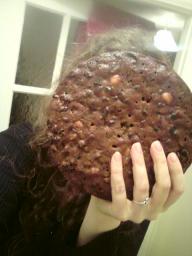
My *attempt* at Levine's Divine Speculaas Rolls
After seeing these amazing looking rolls posted by Freerk ...
http://www.thefreshloaf.com/node/26242/levine039s-divine-speculaas-rolls
...I couldn't help but try making them. Unfortunately, I didn't do justice to the recipe - mine are more style than substance, thanks to some foolish tweaks.

First off, I love the shaping technique - absolutely beautiful. Mine are a bit more clover leaf/hearts looking, and irregular, but I still like it. Now - onto my less successful modifications! As I can't buy aniseed around here, I thought I'd swap the speculaas spices (which sound gorgeous) for some mixed spice, your traditional British Christmas spice mix. The spice taste was pretty mild in the finished rolls though, so I think for mixed spice you definitely need to add much more - Freerk did suggest upping the spice, but with a clove-phobe of a boyfriend, I was a bit wary (more fool me).
My next tweaks were solely based on using what I had/being too cold and lazy to go the shops. :o) I added a couple of drops of lemon oil instead of lemon zest, which came through nicely in the marzipan. Unfortunately, while the dough was rising I used up my last egg in some biscotti, so I only had about half a teaspoon left to mix in with the marzipan. I'm guessing this is why it sort of boiled out a bit rather than setting up more.
Finally, for some reason (probably my somewhat erratic oven) the rolls weren't browning after 15 minutes like the original ones in the photo, so I left them in for another 5-8 minutes. The result: nice and brown but sadly a little bit dry, of course - foolish me! I'm wondering if I can brush them with melted butter or something maybe to moisten them a little...
Anyhow, don't get me wrong: I'd say my efforts tasted about 6 or 7 out of 10, whereas those originals looked like a definite 10 out of 10 to me! What I'm loving about this site is all the inspiration and the chances to practice, experiment and learn from my mistakes, so set backs like this are just getting me thinking... I'm imagining a walnut and honey paste filling, or a pesto style filling, or some kind of hard cheese and spinach, or tapenade....
- dawkins's blog
- Log in or register to post comments
- Printer-friendly version

Purple Wheat Flour
Hi all,
I came across a minche recipe I want to try and it calls for Purple Wheat Flour. Does anyone have experience buying Purple Wheat Flour??
- Log in or register to post comments
- Printer-friendly version

sourdough starter method
this is an excellent article using purple cabbage of all things to make a great sourdough starter. I plan to try it next time I'm at the store looking at cabbage! found on ruhlman.com .........................
- Log in or register to post comments
- Printer-friendly version

Experimenting with pineapple juice instead of water
My "typical" bread recipe consists of combining:
1 cup starter (Gold Medal Whole Wheat, approx. 115~125% hydration, and approx. 7~8 weeks old)
1 cup of water
2 rounded tbsp. of Turbinado (blonde) sugar
1 tsp. salt
Then adding combination of:
3 1/2 cups of Gold Medal Whole Wheat flour
3 level tbsp. of Bob's Red Mill "Vital Wheat Gluten Flour"
I wanted to experiment with pineapple juice (100% not from concentrate - 1 cup) in place of the water; omitted the Turbinado sugar in the recipe.
First rise was really quick - barely 3 hours total. Then a really quick knead and roll, then into the bread pan for the second (final) rise.
Second rise - approximately 12 hours total, before baking.
No noticeable oven-spring during the bake, well, maybe just a little.
Bread came out with a fluffier (maybe softer would be a better description) texture than usual. Had to ease up on the knife while slicing it.
Flavor of the bread...? Not sure. To taste it one wouldn't suspect that I used pineapple juice. Sour taste was the same as with using water. Sweetness from the pineapple juice was very nice.
I'm quite happy with it.
- Log in or register to post comments
- Printer-friendly version
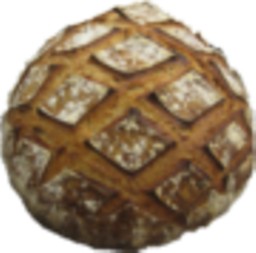
Cranberry Ginger Bread - a work in progress
Hello,
We stopped in at Mix The Bakery in Vancouver awhile back and picked up a loaf of their Cranberry Ginger bread.
This bread was delicious! (I wish I'd taken a picture of it).
Thinking about holiday 'gifts from the kitchen', I thought of this bakery's wonderful Cranberry Ginger bread.
This is a first try at making this bread, using some local, fresh cranberries and ground ginger (along with a bit of lemon zest) for flavor; if I can get this loaf to the point where it tastes like the bakery's, I'll be happy to give this bread to friends and family this holiday season!
The stenciling is for Susan at WildYeast and her upcoming Holiday Edition :^)
Cranberries were popping out all over the place, giving this loaf a bumpy appearance, and the cranberry is bright, bright red in the crumb:
beautiful, local cranberries :^)
These cranberries were juicy, and the first slice didn't slice all that cleanly;
here's the next one, looks a little bit better than the first?
I tossed the cranberries in sugar prior to mixing them into the dough, but even still, these berries are tart!
A little bit of honey on this bread brings the flavors into balance nicely; but the next time I make this, I will try dried, sweetened cranberries in place of fresh.
The ginger flavor is faintly there in the background, so next time I may add some finely chopped fresh, or candied ginger, in addition to the ground ginger. I remember distinctly tasting ginger in Mix The Bakery's loaf; it tasted really good but was not overpowering, so it will take a little bit of tweaking in the next attempt.
I used some locally-grown whole wheat flour in the poolish and levain, and was so happy with the flavor
this contributed to the loaf!
Happy baking, and wishing everyone the best this holiday season,
:^) from breadsong
Submitted to YeastSpotting for Susan's Holiday Edition :^)
- breadsong's blog
- Log in or register to post comments
- Printer-friendly version
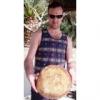
Gilchesters’ Miche/Boules. Double-leavened Dough, made as a Sandwich Loaf and a Boule.
Gilchesters’ Miche/Boules.
Double-leavened Dough, made as a Sandwich Loaf and a Boule.
I have been enjoying using a 3.5kg bag of both the Gilchesters’ “Organic Farmhouse Flour”, and the same size of their “Organic Pizza/Ciabatta Flour” in my breads this week. Alison and I called into the big city [Newcastle!] on Saturday afternoon, en route to our friends’ house in County Durham, to allow me to stock up on specialist flour. I also bought 2 bags of Bacheldre Organic Dark Rye. This must mean a Borodinsky session is not far away!
On Monday this week, I made 4 Gilchesters’ Miche loaves using the same formula and methods as I used today, as posted below. I also used the Pizza/Ciabatta formula with a mix of 2 leavens to make another dough. I baked all this in the wood-fired oven. It continues to be more difficult to build up good bottom heat, but the domed roof is producing a fantastic crust from lovely and gently radiated top heat. I made a boule and 4 baguettines with the second dough. The boule was lovely, but the baguettines convinced me I should not make these solely with natural leaven again. At this stage of my journey, I am only interested in working with the natural leaven. I have very limited capacity, much prefer to use only natural leavens anyway, and my wife has an obvious intolerance of bakers’ yeast as well; all very good reasons. However, a friend had gifted me 2 half stick wires with 2 channels each, so I thought I would at least give them a trial. Anyway, the baking was a success, as I sold all the loaves I made on the day, plus 3 Sourdough Seed breads specially requested by neighbours…which I just happened to have stashed in the freezer.
Since then, I have been working through all my accumulated teaching and learning resources [the paper-based ones!!!], and had a huge “throw out” of all the material I had either duplicated, or that has become out-of-date. Alison was delighted when she got home to watch me filling our Recycling Bin with mountains of paper, previously languishing in cardboard boxes under my desk. I’ve also acquired a website too. More details, obviously to follow, but I have set time to one side 10th and 11th December to work with my brother to build this. He and his wife have a website for their own small business, so I’m utilizing their expertise; how exciting! And I have a Business Plan to write too! These are my pre-Christmas plans, as well as circulating samples of bread to local businesses and flyers through peoples’ letter boxes in the village. The MSc kicks off again later in January, so I need a regular income by then…although it will only be small, and things will be tight in our household. It’s a tough time, but Alison knows how to keep me up-beat and confident this venture will be a big success for both of us. That’s not easy when I know how much she must be worried too.
Anyway, onto the breads for today. I built both my rye sour and wheat levain up over the course of yesterday. The wheat leaven had 3 refreshments and the rye sour had 2. I began with 40g of each in stock, and ended up with around 340g of rye sour and 980g of wheat leaven. I have returned 40g of each to stock, and used up the rest in the formulae posted below.
1. Gilchesters’ Miche/Boules
Material/Stage | Formula [% of flour] | Recipe [grams] |
1. Wheat Levain |
|
|
Marriage’s Organic Strong White Flour | 25 | 500 |
Water | 15 | 300 |
TOTAL | 40 | 800 |
|
|
|
2. Final Dough |
|
|
Wheat Levain [from above] | 40 | 800 |
Gilchesters’ Organic Farmhouse Flour | 75 | 1500 |
Salt | 1.8 | 36 |
Water | 56 | 1120 |
TOTAL | 172.8 | 3456 |
|
|
|
% pre-fermented flour | 25 | - |
% overall hydration | 71 | - |
% wholegrain flour [approx 85% extraction] | 75 | - |
FACTOR | 20 | - |
Method:
- Build the levain, see description above.
- For mixing, first of all mix on first speed for 3 minutes with a hook attachment, then autolyse the Gilchesters flour with the water for 1 hour.
- Add the levain and the salt. Mix on first speed for 2 minutes, then second speed for 7 minutes.
- Bulk prove the dough maintaining DDT of 26°C for 2 hours.
- Scale and divide as follows: 2 pieces @ 525g, one @ 1050g and the remaining piece @ c.1350g. Mould round and rest for 15 minutes. Prepare bannetons, re-mould dough pieces and set to final proof.
- Final proof DDT maintained at 27°C, for 2 hours
- Tip each loaf out of the banneton onto a peel, score the top and set to bake on the sole of the wood-fired oven. Small loaves bake in half an hour, next biggest takes 45 minutes and the biggest loaf took around 55 minutes.
- Cool on wires.
I set these loaves in the oven with the top heat reading in excess of 300°C and even the bottom heat was close on 280°C. I was confident it would settle out; this is easily the best firing I have achieved with this oven; so very pleasing.
2. Double-leavened Dough, made as a Sandwich Loaf and a Boule.
Material/Stage | Formula [% of flour] | Recipe [grams] |
1a. Rye Sourdough |
|
|
Bacheldre Organic Dark Rye Flour | 11 | 110 |
Water | 18.3 | 183 |
TOTAL | 29.3 | 293 |
|
|
|
1b. Wheat Levain |
|
|
Marriage’s Strong Organic White Flour | 8.4 | 84 |
Water | 5 | 50 |
TOTAL | 13.4 | 134 |
|
|
|
2. Final Dough |
|
|
Rye Sourdough [from 1a] | 29.3 | 293 |
Wheat Levain [from 1b] | 13.4 | 134 |
Gilchesters’ Organic Pizza/Ciabatta Flour | 62 | 620 |
Marriage’s Strong Organic White Flour | 13 | 130 |
Gilchesters’ Organic Farmhouse Flour | 5.6 | 56 |
Salt | 1.8 | 18 |
Organic Butter [slightly salted] | 1.8 | 18 |
Water | 43.7 | 437 |
TOTAL | 170.6 | 1706 |
|
|
|
% pre-fermented flour | 19.4 | - |
% overall hydration | 67 | - |
% wholegrain flour | 16.6 | - |
FACTOR | 10 | - |
Method:
- Build the leavens as described above.
- Weigh all the ingredients into the mixing bowl. Attach a dough hook and mix on first speed for 2 minutes. Scrape down as needed. Mix on second speed for 7 minutes.
- Bulk proof for 1½ hours, DDT maintained at 27°C.
- Scale and divide, 4 pieces @ 300g for a Sandwich loaf, leaving one piece of just over 500g for a small boule. Mould round and rest for 15 minutes. Prepare one banneton and one large Pullman Pan. Re-mould the boule, and shape the four pieces ready and tin up. Attach the pan lid and set both for final proof.
- Final proof; the boule took 2 hours and was loaded with the Gilchester loaves. The panned loaf stood 3 hours and was baked in the wood-fired oven straight after all the other loaves were baked. The Sandwich loaf baked in 50 minutes.
- Cool on wires.
Plenty of photos attached. The wood-fired oven behaved as it has never done so far. When I set the panned loaf in the oven the top heat was still at 250°C and the bottom heat sitting nicely at 220°C. This is so solid compared to previous baking and is really bolstering my confidence that I will be able to bake more in it than I had originally feared might be the case.
The builders across The Square are my latest fans; they bought 3 loaves and have placed an advanced order for Monday already. The rest is for Alison and I and, hopefully, a trip to our local town, Wooler, tomorrow see if one of the shop’s is interested in taking it as samples. We shall see?
Happy Baking!
Andy
- ananda's blog
- Log in or register to post comments
- Printer-friendly version

Gilding the lily
Believe it or not, Floyd's Sweet Potato Rolls can be made even better. And I wouldn't even have known that but for a bit of Thanksgiving serendipity.
My youngest daughter and family had been in town for a visit the weekend prior to Thanksgiving. For one of our meals, she made Elizabeth Karmel's Sweet Potato Bourbon Mash. Sweet potatoes are one of my favorite things and they play very nicely with a bit of bourbon. Needless to say, the dish was delicious!
A few days later, I was planning to take some rolls to our older daughter's home for Thanksgiving dinner and decided that the sweet potato rolls would be in keeping with the day. As luck would have it, there was about 3/4 of a cup of the sweet potato bourbon mash left over; just the perfect amount for the rolls.
The dough came together nicely and the rolls baked up prettily, filling the house with their fragrance. They tasted even better than they smelled! As our daughter put it after taking a bite, "It's like Thanksgiving in your mouth!"
So, if you feel the need for a bit of self-indulgence, I'd highly recommend this. In effect, you get a two-for-one deal, since the sweet potato mash is worth doing in its own right.
Paul
- pmccool's blog
- Log in or register to post comments
- Printer-friendly version

Levain with 2 starters redux
Just baked my "regular" sourdough yesterday and decided it truly is the best bread ever. It's Hamelman's 'Levain with 2 starters,"on pp. 162, 163 of Bread. It makes keeping that second, rye starter worth every minute it takes (not very many at that). We just cut into it last night after it had cooled about 3 hours, and hubby and I (just two bread-loving retired folks) went through at least a third of a loaf that weighed 2 pounds! I shaped it as a chubby batard. I didn't photograph the second loaf (which was a little under 1 1/2 lbs., more of a baguette-like shape but a little chunkier) because it went into the freezer right after it cooled. I slashed both loaves with a single center cut.



I hesitate to reproduce the recipe because of copyright restrictions. (If anyone has knowledge of getting around that, let me know and I'll see if I can comply.) I pretty much bake it as Hamelman directs (there are no errata listed for this recipe). My only tweak is the sprinkling of seeds on top, which I often do. I combine sunflower, sesame (black and white), fennel, flax and poppy, along with freshly ground sea salt (not too much), which I keep in a small plastic container in the fridge. I use that as a bagel topping as well.
This is our regular table bread, and I often retard it overnight (up to 18 hours at 42 deg. F., Hamelman advises), which makes it a 3-day affair, with the starters being mixed the night before mixing the dough. We had visiting relatives from Israel in October who said this is the best bread they ever ate (my sentiments exactly)! This time I felt like baking it the same day as mixing, and it was at its best! So delicious! I think it may be because the flour was very fresh (K.A. bread flour and B.R.M. whole rye, both just opened yesterday). My autolyse time was short (15 minute), as I had a dr. appt. in the middle of it all. I did two S & F's (somewhat sticky dough, manageable with wet dough scraper and wet hands), and I baked it on a stone (preheated in 500 deg. oven 45 minutes before loading) with the usual steam (pan of steaming hot water beneath and spritzing 4 or 5 times the first 10 minutes). After 15 minutes, I turned the oven to convection (my K/A electric oven automatically converts Hamelman's 460 F. to 435 F.) after removing the steaming pan--carefully. I actually lowered the oven 10 degrees for the final 10 minutes, as it sometimes gets a little too dark. Total baking time is 40-45 minutes. So, if you have Hamelman's book (or a copy from the library) and if you're willing to whip up two starters (he has directions in the book for both white and rye starters), it's worth it! The flavor is unbelievably delicious, and it keeps in a paper bread bag for the better part of a week (I bought 500 of them from a local supplier recommended by a local bakery) and then makes great croutons. I'm saving the second loaf for a dinner party hosted by a member of my book group (an amazing cook and former caterer).
Joy
- Log in or register to post comments
- Printer-friendly version


